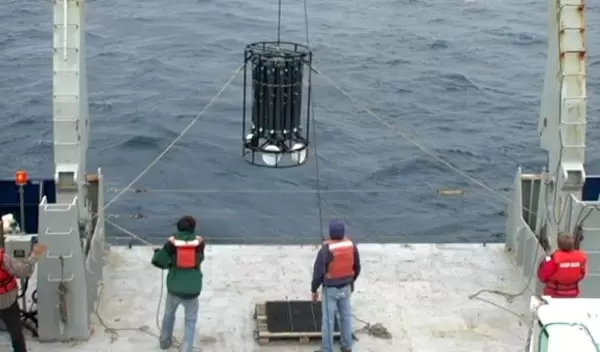
Mysterious Compound Seen as Key to Ocean Life
When bits of natural organic matter from leaves and other sources break down, they can enter rivers and ponds and cause a buildup of yellow-brown organic matter that amasses as the tiny plants die.
The drab material is known as chromophoric dissolved organic matter (CDOM), and, while its origin is fairly well known in coastal and inland waterways, scientists know far less about the origin and chemical composition of the material in the oceans.
Some scientists believe heterotrophs (organisms that cannot produce their own food--such as bacteria--produce and release the mysterious group of organic chemical compounds into the organisms' surrounding environment as they decay. New studies are now focusing on understanding CDOM in the oceans.
Researchers know that CDOM, when struck by sunlight, plays a critical role in ocean chemistry. It impacts reactions that can affect greenhouse gas emissions that can, in turn, warm the planet; sulfur compounds that can cause cloud formation that can cool the planet; and iron concentrations that are critical to ocean plants.
By understanding marine CDOM, scientists will better understand life in the oceans, and particularly, how organisms and compounds in the seas are affected by light.
One group of U.S. scientists has been studying CDOM since 2003, with several members recently traveling aboard the research vessel Roger Revelle to look at the material both at and below the ocean's surface.
According to University of California at Santa Barbara researcher Norm Nelson, nobody's done this before. Few have looked at oceanic CDOM anywhere except in the surface layer of the ocean where it's illuminated by the sun. That's why the researchers are grateful for the chance to go to sea.
"It's a great opportunity to go to sea to test our hypotheses and discover new things," said Nelson. "It's worth all the long hours, and the weather, and all the difficulties of travel."
Because CDOM is an emerging area of study, the CLIVAR/CO2 Steering Committee selected the researchers to participate in selected CLIVAR cruises. (CLIVAR is an international, interdisciplinary research effort focusing on climate variability and predictability.) The CDOM group has received renewed funding from the National Science Foundation (NSF) for some of these cruises and NASA has recently granted funding for optics work.
So how exactly does a researcher get involved in studying matter of such mysterious origins? Often it starts out simply as curiosity.
"We got into the study of CDOM by accident," said Nelson. "My colleagues discovered the presence of an unknown factor that controlled the color of the Sargasso Sea off Bermuda that wasn't phytoplankton (tiny marine plants), which we'd always assumed was the most important. I made some measurements that demonstrated it was CDOM, and a whole new area of research opened up for us."
By studying the amount of light going into and coming out of the ocean, scientists can validate ocean-color remote-sensing measurements and quantify the light available for photochemistry and photobiology. These are related directly or indirectly to CDOM.
On the I8S CLIVAR/CO2 cruise aboard the Roger Revelle, scientists measured CDOM levels below the surface using a suite of instruments such as a hand-held profiler that principally contains light sensors and a spectrophotometer that measures how much light is absorbed by CDOM at different wavelengths (colors) of light. They also used instruments that face upward and measure light coming from the sun and instruments that face downward to measure the radiance spectrum (a measure of light color bouncing back). The hand-held profiler also contains a fluorometer to measure chlorophyll in plants and a sensor to measure turbidity--the amount of tiny debris particles floating in the water.
The researchers also used an innovative instrument called the CTD (Conductivity, Temperature, Depth recorder) rosette, a system of specialized bottles attached to a metal framework that travels deep into the water column to gather samples. As one of the primary instruments for the CLIVAR cruise, the CTD collected water that researchers later analyzed for a range of information, and it also houses additional sensors. In addition to the sensor data they obtained, the researchers collected actual CDOM specimens and phytoplankton, as well as information about the impact of bacteria.
The detailed study of CDOM will help researchers bring Earth-based data to bear on years of satellite measurements of phytoplankton. By absorbing ultraviolet and blue light and making the ocean appear more yellow, CDOM plays an important role in controlling the color of the ocean, as observed by satellites. Scientists estimate the amount of chlorophyll present in seawater by measuring how green the water appears to satellites, and CDOM (in concert with the blue color reflected by ocean water) helps make the ocean appear greener than it is, throwing off estimates of how much phytoplankton there is in the seas.
In addition to providing fundamental information about the nature of CDOM, the new studies will allow scientists to validate remote sensing estimates of marine plant biomass and productivity, and may open new possibilities for using ocean-color remote sensing with studies in areas such as photochemistry, the photobiology of ultraviolet radiation and even ocean circulation.
-- Cassandra Lopez, University of Miami clopez@smas.miami.edu
This Behind the Scenes article was provided to LiveScience in partnership with the National Science Foundation.
